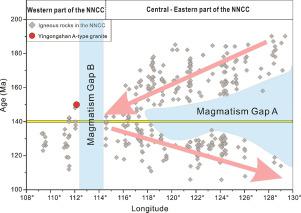Lithos ( IF 3.5 ) Pub Date : 2021-04-16 , DOI: 10.1016/j.lithos.2021.106167 Shuang Gao , Wei-Feng Chen , Hong-Fei Ling , Li-Qiang Sun , Quan Ren , Guo-Ai Xie , Kai-Xing Wang , Rong-Song Tian

|
The Late Jurassic tectonic environment of western part of northern margin of the North China Craton (NNCC) remains poorly understood due to weak magmatism in the Jurassic period and complications by supposedly superimposed effects of activities related with the Mongol-Okhotsk and the Paleo-Pacific tectonic regimes. In this study, we for the first time discovered and reported an A-type granite (Yingongshan granite) in the western NNCC in the Late Jurassic period. The Yingongshan granite is dated at 150 Ma years old. The Yingongshan granite is characterized by high contents of total alkalis (Na2O + K2O = 8.23–9.51%) and high field strength elements (Zr + Nb + Ce + Y = 289–705 ppm) and Ga/Al ratios (10,000 × Ga/Al = 3.01–4.05). Based on these geochemical characteristics and differentiation trend, it can be reasonably inferred that initial composition of the Yingongshan granitic melt exhibited an A-type magmatic affinity. In addition, results of zircon saturation thermometer show high magmatic temperature (> 887 °C) for the initial magma, which is consistent with its A-type granite affinity. Furthermore, the Yingongshan granite showed negative εNd(t) values (−14.5 to −13.3) and zircon εHf(t) values (−13.6 to −17.4) and contain mafic magmatic enclaves. Compared with the host Yingongshan granite rocks, the enclaves showed even lower εNd(t) values (−14.9 to −14.6) and zircon εHf(t) values (−16.9 to −19.5). Such “reversed isotope” characters indicate injection of a magma derived from the enriched lithospheric mantle during formation of the Yingongshan A-type granite. Therefore, we suggest that the latest Jurassic Yingongshan A-type granite was derived from partial melting of preexisting calc-alkaline granitoids in the crust at low pressure and high temperature under influence of magma intrusion derived from the enriched lithospheric mantle. Discovery of the Yingongshan A-type granite in this study indicates that local extension occurred as early as 150 Ma in the western NNCC, although previous studies suggest that extensive extension occurred since 132 Ma. In addition, based on the data obtained in this study combined with statistics of published zircon U–Pb age data and distribution localities of magmatic rocks in the NNCC from the literatures, we suggest that the latest Jurassic local extension in the western NNCC revealed in this study may have resulted from the collapse of the Mongol-Okhotsk orogen.
中文翻译:

内蒙古中部最新的侏罗纪A型花岗岩:岩石成因与构造意义
由于侏罗纪时期的岩浆作用较弱,并且由于与蒙古-鄂霍次克和古太平洋构造有关的活动的叠加作用而引起的并发症,对华北克拉通北部边缘西部的侏罗纪晚期构造环境仍然知之甚少。政权。在这项研究中,我们首次在侏罗纪晚期发现并报道了NNCC西部的一种A型花岗岩(Yingongshan花岗岩)。Yingongshan花岗岩的历史可追溯到150 Ma年。鹰公山花岗岩的特征是总碱含量高(Na 2 O + K 2O = 8.23–9.51%)和高场强元素(Zr + Nb + Ce + Y = 289–705 ppm)和Ga / Al比(10,000×Ga / Al = 3.01–4.05)。根据这些地球化学特征和分化趋势,可以合理地推断,银公山花岗岩熔体的初始成分表现出A型岩浆亲和力。此外,锆石饱和温度计的结果表明,初始岩浆的岩浆温度较高(> 887°C),这与其A型花岗岩的亲和力是一致的。此外,花岗岩Yingongshan显示阴性ε的Nd(t)值(-14.5至-13.3)和锆石ε的Hf(t)值(-13.6至-17.4)和含有镁铁质岩浆飞地。与宿主的应宫山花岗岩相比,飞地的ε值更低钕(t)值(-14.9至-14.6)和锆石ε铪(t)值(-16.9至-19.5)。这种“反同位素”特征表明,在Yongongshan A型花岗岩形成过程中注入了富集岩石圈地幔的岩浆。因此,我们认为最新的侏罗纪银贡山A型花岗岩是由早先存在的钙碱性花岗岩在地壳中在低压和高温下在富集岩石圈地幔引起的岩浆侵入的影响下部分熔融而获得的。在这项研究中发现的银公山A型花岗岩表明,早在NNCC西部,局部扩张就发生在150 Ma,尽管先前的研究表明,自132 Ma以来就发生了广泛的扩张。此外,


























 京公网安备 11010802027423号
京公网安备 11010802027423号